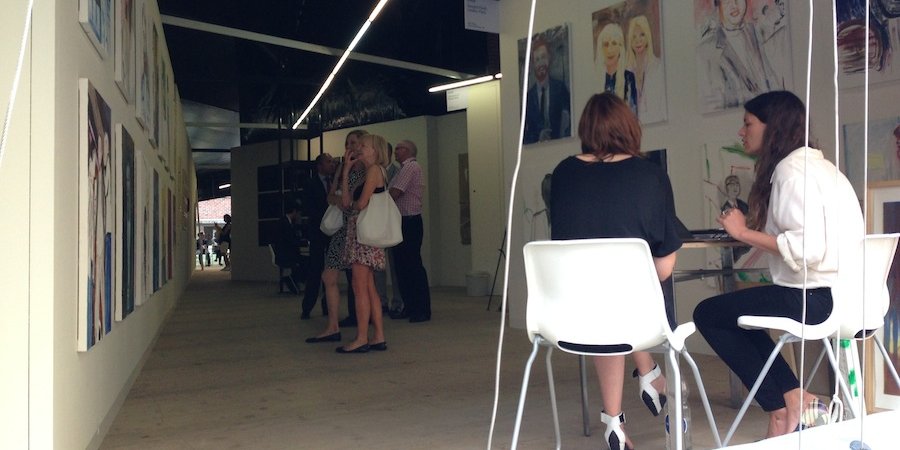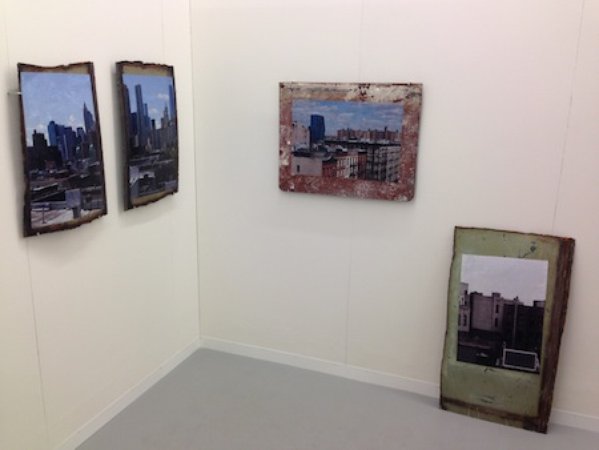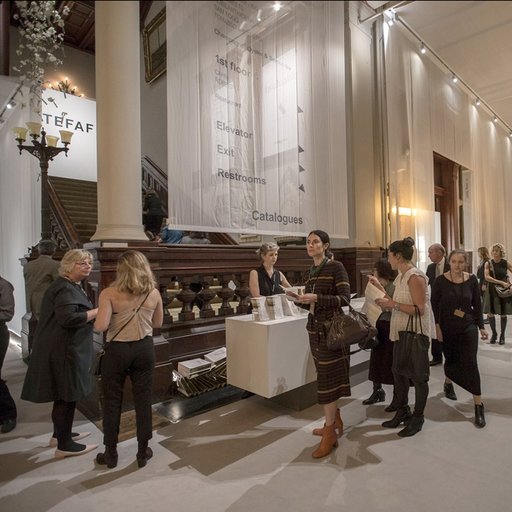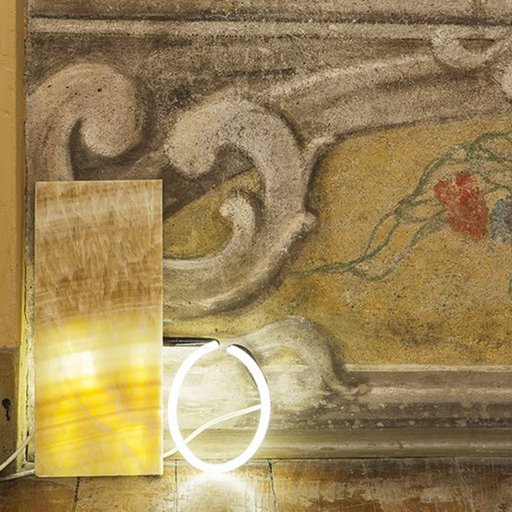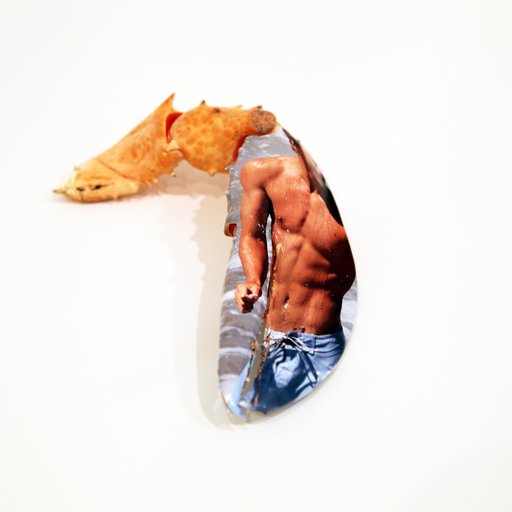Every year, collectors on the hunt for new art head to Liste , the alternative art fair created to function as the more experimental adjunct to Art Basel —a place where the most promising young artists, chosen by a secret panel of international museum curators, test out new processes, formats, and aesthetic gambits. As a result, it's a great place to find out how the latest generation of the avant-garde is thinking about Art, and, as one can tell from the common threads shared by much of the work on view, great minds often think alike.
To explore the new directions that art seems to be moving today, we teased out a few trends from the work on display in the booths. One overarching trend, it should be noted, is that despite the fact that these artists are coming of age in the era of the Internet, the art they're creating is decidedly low-fi, frequently with an eye to history and the formal, physical properties of their chosen mediums.
RELATED LINKS:
Expert Eye: Liste Director Peter Bläuer on Basel's Scrappiest Art Fair
CONSTRUCTION MATERIALS
One of the most apparent trends at the fair revolves around the employment of construction materials, a tactic that pays homage to sculpture's ancient history—the marble, bronze, stone, etc., that composed the statues of antiquity also erected the world's great edifices—but adds a contemporary twist that seems to reference commodity culture, architecture, and even urban planning. Such is the case with artist Dena Yago 's compelling, shabby chic objects at Berlin's Sandy Brown gallery, which affix photographs taken from New York rooftops to panels of rusty found scrap metal. The patina of the material gives the compositions a painterly effect, and fused with the urban photos conjure up a gritty, romantic vision of the city and it's edgy bad old days—a kind of exoticism and frontier mentality that is also alluded to by a single tumbleweed in the center of the booth.
This piece by the Algerian-born, Paris-based artist Mohamed Namou at Paris's Mor · Charpentier Galerie consists of granite and three hefty chunks of finished wood (the kind that would form a kitchen table, say) arrayed on a spartan metal shelf. It's sculpture that seeks to accomplish the bare minimum required of an artwork, a liminal and rather existential place sought by many artists in the fair. Is it art? You figure it out, the artist dares the viewer.
Here we go: two fat slices of marble, served sushi-style atop a white plinth by Charbel-joseph H. Boutros at the booth of Dubai's Grey Noise . It's squarely (ha) in the tradition of Brancusi's explorations of the sculpture-plinth relationship, and again invokes the prefab aesthetics of the home (again think kitchen, or the master bathroom).
These two hefty slabs of concrete at Bogota's Instituto de Visión are by Carolina Caycedo , who covered them with a photographic study of a dam, El Quimbo, under construction at the origin of Colombia's Magdalena river. Built from the same material as the sculpture, the dam and its containment of the region's water represents for the artist an analogue to her country's political repression.
At Gaudel de Stampa , from Paris, Lina Viste Gronli has played mason by mortaring together red fired bricks with classic books from the Western cannon (here novels by Charles Dickens , James Joyce in another piece). Literalizing these books' status as the building blocks of a refined education (the title of this piece is Societal Structure ), the sculpture would make a nice addition to an art collector's library. (Note the orange accents of the paperbacks' spines, well chosen to match the hue of the bricks.)
STICKS & STRAPS
An offshoot of the building materials trend, another strain of art running through the fair seems to pick up André Cadere 's walking-stick format and run with it, with artists creating thin vertical artworks to lean against the wall. This piece by Sam Ekwurtzel at New York's Simone Subal Gallery (which displayed other versions of this work at his recently closed solo show) consists of poles that the artist painstakingly created by cobbling together knots of wood that he must have cut out of countless other planks.
Something of an outlier (and a welcome one) among the fresh-faced youths of Liste, the acclaimed mid-career artist Virginia Overton shows the kids how stick art is done with this piece at Zürich's Freymond-Guth Fine Arts . Composed of a sliver of 2x4 strapped to a metal pole and perched atop a rock, this piece balances audaciously on the precipice of non-art and peers steely eyed into the abyss below. If you look around your basement you might find one of these naturally occurring in a corner somewhere.
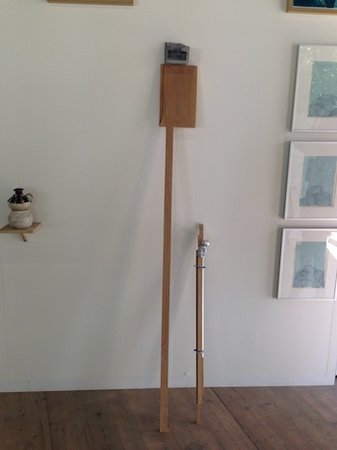
Brendan Earley at Dublin gallery mother's tankstation fancies himself something of a handyman, and he likes the idea of making art by "fixing" things in a sort of demented way. Here he has helpfully repaired a few sticks of wood by strapping them together with zip ties and topping them off with pieces of styrofoam that he has painted grey to look like cement. Now these sticks work great—good as new.
Did you know that young artists have a thing for zip ties? At Belgium's Office Baroque Gallery , Kyle Thurman used his to bind together some corrugated-rubber floor matting that he sliced up into ribbons.
HARD PAINTINGS
This trend is a subcategory of the building-material one, actually: artists embellishing construction supplies and sticking them on the wall as paintings. At Sabot Gallery of Cluj-Napoca, Radu Comşa has inlaid colored paper into cast concrete to create these elegant abstractions. Talk about Concrete art.
George Henry Longly of London's Jonathan Viner Gallery has embedded four sections of table-top ready marble with Yves Saint Laurent mascara cases and whippit canisters, then cut out letters in the marble to spell "Live Your Life." Ke$ha needs one of these for her cool-out room, stat.
Mohamed Namou's affection for building materials has already been mentioned here, but this wall piece fits nicely into the painting trend too, with bits of marble stuck into pouches in the yellow canvas. Finally, someone thought to give paintings pockets! So convenient.

Porcelain isn't a building material, per se, but this gorgeous piece by Thea Gvetadze at Tbilisi's Gallery Nectar warrants a mention because it's just so impressive. Composed of individually fired sections that the artist puzzle-pieced together into a coherent painting shape, it's a melodic fusion of tropical, Gauguin-ish colors and crisp lines, some etched into the ground and some formed by the gaps between the sections. Incredibly, it's the first time the Gvetadze has made anything like this.
FLAT PAINTINGS
Flat paintings have been all the rage since Clement Greenberg declared flatness to be the chief material property of the medium ("the only condition painting share[s] with no other art"), and many of the artists at Liste are nothing if not formalists. Well, you can't get much flatter than dying the pigment straight into the canvas—as the Washington Color Field painters knew—so that's what Beni Bischof did here at Berlin's Sommer & Kohl gallery.
This beautiful painting by Patricia Treib at New York's Wallspace gallery is as light as a breeze, a few sure-handed swipes of thin paint forming an interior of sorts, with Matiss ian blue and yellow shapes adjoining a fresh swath of delicate pink.
Antonio Ballester Moreno at Madrid's Maisterravalbuena gallery presents a comic scene: haha... yikes. Somehow this suggests what a Carroll Dunham scenario might look like before it goes all squiggly.
At Guatamala's Proyectos Ultravioleta gallery, Federico Herrero has made a gentle nighttime scene out of blocks of color and pen-drawn doodles and a couple splurts of spray paint. It's a lot of fun.
Ryan McLaughlin 's paintings at New York's Laurel Gitlen Gallery are brushy affairs that carry a whiff of the barnyard, as if a 19th-century New England farmer made these oddly engaging and graphically punchy compositions under the cover of darkness, for fear of scandalizing his neighbors. In such a scenario, this might be that farmer's favorite hen, Bessie .
DENIM
What's more low-fi than denim? Giulia Piscitelli at Italy's Galleria Fonti in Napoli made this sculpture by coating a hardy "work uniform" in latex. Jeans have finally completed their ascent up the ladder, from workwear to casual attire to business casual to status symbol and now to art.
Some people hate it when they get paint on their jeans. Rubén Grillo at NoguerasBlanchard of Barcelona/Madrid loves it.
The granddaddy of denim artists, Korakrit Arunanondchai merely needs to gesture toward his favorite fashion staple at Liste, contributing this acid-washed pillow printed with a single blazing jeans jacket at London's Carlos/Ishikawa gallery. Totally off-the-cuff but expertly on-trend, this piece epitomizes the laid-back ethos at this year's Liste.











